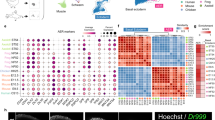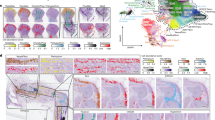Abstract
The generation of supernumerary limbs by rotation of amphibian limb buds or regeneration blastemas is a phenomenon well known to embryologists1,2. The recent revival of interest in this aspect of limb morphogenesis has been largely due to the stimulus provided by the polar coordinate model for control of limb outgrowth and pattern3 and subsequent efforts to test its validity. The geometrical rules postulated in the polar coordinate model make precise predictions about the handedness of supernumerary limbs. Following antero-posterior (AP) or dorso-ventral (DV) inversions, they should be of the same handedness as the stump, whether single or in pairs, but after inversion of both axes (APDV) pairs should be of opposite handedness3. It is surprising, therefore, that the structure of supernumerary limbs has never been studied in sufficient detail to report whether they really are normal limbs, for only the skeletal elements are examined in cleared whole mounts (see Fig. 1). This only allows an assessment of the AP axis, and to determine the dorsal and ventral surfaces (and hence the handedness), the curvature of the digits is noted. I therefore decided to study the muscle patterns of all types of supernumeraries, and report here that, contrary to expectation, the majority of APDV supernumeraries are not normal limbs but are mirror-image duplications in the dorso-ventral axis, that is, either double-dorsal or double-ventral. This presents problems for contemporary models of pattern formation in the limb, and issues a warning to those who use supernumerary limbs as an experimental tool to investigate other areas of developmental biology.
This is a preview of subscription content, access via your institution
Access options
Subscribe to this journal
Receive 51 print issues and online access
$199.00 per year
only $3.90 per issue
Buy this article
- Purchase on Springer Link
- Instant access to full article PDF
Prices may be subject to local taxes which are calculated during checkout
Similar content being viewed by others
References
Abeloos, M. & Lecamp, M. C. r. hebd. Séanc. Acad. Sci., Paris 192, 639–641 (1931).
Harrison, R. G. J. exp. Zool. 32, 1–136 (1921).
French, V., Bryant, P.J. & Bryant, S. V. Science 193, 969–981 (1976).
Grim, M. & Carlson, B.M. Z. Anat. Entwickl.-Gesch. 145, 137–184 (1974).
Tank, P. W. Devl Biol. 62, 143–161 (1978).
Wallace, H. & Watson, A. J. Embryol. exp. Morph. 49, 243–258 (1979).
Maden, M. & Turner, N. Nature 273, 232–235 (1978).
Slack, J. M. W. J. theor. Biol. 82, 105–140 (1980).
Turner, N. & Maden, M. (submitted).
Author information
Authors and Affiliations
Rights and permissions
About this article
Cite this article
Maden, M. Structure of supernumerary limbs. Nature 286, 803–805 (1980). https://doi.org/10.1038/286803a0
Received:
Accepted:
Published:
Issue Date:
DOI: https://doi.org/10.1038/286803a0
This article is cited by
-
FGF8 and SHH substitute for anterior–posterior tissue interactions to induce limb regeneration
Nature (2016)
-
Axial characteristics of nerve induced supernumerary limbs in the axolotl
Wilhelm Roux's Archives of Developmental Biology (1984)
Comments
By submitting a comment you agree to abide by our Terms and Community Guidelines. If you find something abusive or that does not comply with our terms or guidelines please flag it as inappropriate.



